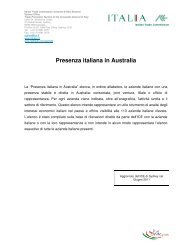Price Determination in the Australian Food Industry A Report
Price Determination in the Australian Food Industry A Report
Price Determination in the Australian Food Industry A Report
Create successful ePaper yourself
Turn your PDF publications into a flip-book with our unique Google optimized e-Paper software.
OILSEEDS – OVERVIEW<br />
Background<br />
The oilseed <strong>in</strong>dustry is predom<strong>in</strong>antly export-focused, although this varies between crops. The<br />
ma<strong>in</strong> commodity used <strong>in</strong> retail cook<strong>in</strong>g oil and margar<strong>in</strong>e is canola, with smaller quantities of<br />
sunflower and soybeans. This report focuses on canola because it represents over 50 per cent of<br />
<strong>the</strong> oils and fats used <strong>in</strong> <strong>the</strong> domestic retail market.<br />
Australia produces on average 1.6–1.8 million tonnes of canola annually, of which around 400,000<br />
tonnes is used <strong>in</strong> <strong>the</strong> domestic crush<strong>in</strong>g sector almost exclusively for products for <strong>the</strong> domestic<br />
<strong>in</strong>dustry. As such, <strong>in</strong>ternational price movements of both canola and <strong>the</strong> compet<strong>in</strong>g oils and fats<br />
crops are <strong>the</strong> major factor <strong>in</strong>fluenc<strong>in</strong>g raw material prices. As <strong>in</strong> o<strong>the</strong>r agricultural bus<strong>in</strong>esses,<br />
because <strong>the</strong> raw material is <strong>the</strong> major cost component, <strong>the</strong> <strong>in</strong>fluence of <strong>in</strong>ternational prices is felt<br />
right through <strong>the</strong> value cha<strong>in</strong>.<br />
The <strong>in</strong>dustry’s product mix and use<br />
The <strong>in</strong>dustry uses a range of oils and fats <strong>in</strong> its product range (see graph below). However, many of<br />
<strong>the</strong> more important <strong>in</strong> terms of total volume are not used <strong>in</strong> retail products, namely tallow, palm<br />
and cottonseed.<br />
Figure 84. <strong>Industry</strong>’s use of oils and fats<br />
1994–1995<br />
canola sunflower o<strong>the</strong>r soft oils olive<br />
soybeans cottonseed palm tallow<br />
1999–2000<br />
2000–2001<br />
2001–2002<br />
2002–2003<br />
0 100 200 300 400 500 600 ’000 tonnes<br />
<strong>Price</strong> <strong>Determ<strong>in</strong>ation</strong> <strong>in</strong> <strong>the</strong> <strong>Australian</strong> <strong>Food</strong> <strong>Industry</strong> A <strong>Report</strong><br />
Source: <strong>Australian</strong> Oilseeds Federation<br />
All palm and most olive oil is imported, with both <strong>the</strong>se commodities grow<strong>in</strong>g <strong>the</strong>ir share of <strong>the</strong><br />
market. For palm oil this growth is price-based and for olive oil it is lifestyle and image-based.<br />
The graph above illustrates that canola has steadily <strong>in</strong>creased share as production has <strong>in</strong>creased<br />
(except for <strong>the</strong> impact of <strong>the</strong> 2002–03 drought). Canola has now replaced all o<strong>the</strong>r soft oil usage<br />
that does not have an <strong>in</strong>tr<strong>in</strong>sic demand.<br />
The retail market is an important segment for <strong>the</strong> oils and fats <strong>in</strong>dustry <strong>in</strong> terms of value but is less<br />
important <strong>in</strong> terms of volume – see graph below. The retail market is not grow<strong>in</strong>g o<strong>the</strong>r than for <strong>the</strong><br />
olive oil and value-added segments, such as plant sterol-enhanced margar<strong>in</strong>es. The food service<br />
and food manufactur<strong>in</strong>g sectors are grow<strong>in</strong>g by around 2 per cent per annum.<br />
Figure 85. Market mix of <strong>the</strong> <strong>in</strong>dustry’s use of oils, 2002<br />
commercial<br />
37%<br />
food service 28%<br />
Source: <strong>Australian</strong> Oilseeds Federation<br />
retail 35%<br />
80







